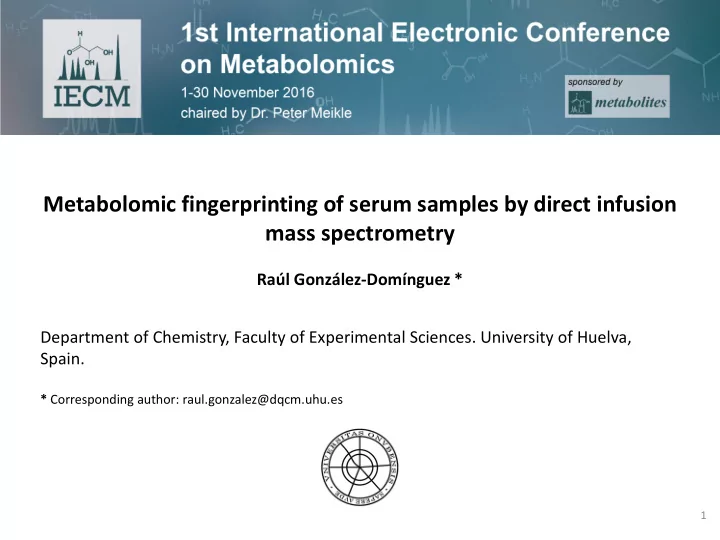

Metabolomic fingerprinting of serum samples by direct infusion mass spectrometry Raúl González-Domínguez * Department of Chemistry, Faculty of Experimental Sciences. University of Huelva, Spain. * Corresponding author: raul.gonzalez@dqcm.uhu.es 1
Metabolomic fingerprinting of serum samples by direct infusion mass spectrometry Graphical Abstract 2
Abstract: Metabolomics has demonstrated a great potential in numerous biomedical research fields in the last years, such as the study of the underlying pathology of diseases, discovery of diagnostic biomarkers or drug development. Nowadays, the main challenge in metabolomics is to obtain comprehensive and unbiased metabolomic profiles due to the huge complexity, heterogeneity and dynamism of the metabolome. For this purpose, mass spectrometry represents a very interesting analytical platform, since complexity of metabolome may be overcome through the use of different orthogonal separation techniques, including liquid chromatography, gas chromatography and capillary electrophoresis. Alternatively, direct mass spectrometry analysis, either by direct infusion or flow injection, has been postulated as an alternative in metabolomics, complementing hyphenated approaches. These techniques exhibit several advantages such as the ability for high-throughput screening, fast analysis and wide metabolomic coverage, since there is not exclusion of compounds due to the separation device. The present work explores the potential of metabolomic platforms based on direct infusion mass spectrometry for metabolic fingerprinting of serum samples. The most important issues to be considered in this type of approach were reviewed, including sample handling, comprehensive analysis, as well as further identification of metabolites and global characterization of metabolomic fingerprints. Keywords: metabolomics; direct infusion mass spectrometry; serum 3
Introduction Mass spectrometry – based metabolomics • High sensitivity and selectivity • Qualitative and quantitative analysis • Analysis of complex samples • Versatility Ionization mode ( ESI , APCI, APPI) Sample introduction (chromatography, capillary electrophoresis, direct infusion ) 4
Introduction IONIZATION MODE • The huge complexity and heterogeneity of metabolome make necessary the use of complementary ionization modes Electrospray (ESI): ionizes compounds over a large mass range (largely used in metabolomics) Atmospheric pressure chemical ionization (APCI): analysis of less polar compounds Atmospheric pressure photoionization (APPI): non-polar compounds, low susceptibility to matrix effects 5
Introduction SAMPLE INTRODUCTION i. Combination with separation techniques (LC, GC, CE): reduction of mass spectra complexity ii. Shotgun analysis (direct infusion or flow injection) • Short analysis time • High sensitivity • Instrumental reproducibility • Non-discriminant analysis • Simpler data pre-processing High-throughput metabolomic fingerprinting 6
Objectives Development of a metabolomic approach based on direct infusion mass spectrometry (DIMS) for high-throughput fingerprinting of serum samples • Protocol for exhaustive extraction of metabolites from serum • Analysis by direct infusion - electrospray - high resolution mass spectrometry (DI-ESI-QTOF-MS) • Characterization of metabolomic fingerprints in order to assess the metabolome coverage 7
Results and discussion 1. METABOLITES EXTRACTION • Common procedures based on protein precipitation with organic solvents fails to extract lipophilic components, which may remain adsorbed to protein precipitate • Optimization of a two-step serum extraction method 100 µ l serum + 400 µ l MeOH:EtOH 50% Precipitate + 400 µ l Supernatant POLAR EXTRACT MeOH:CHCl 3 50% LIPOPHILIC EXTRACT 8
Results and discussion 2. METABOLOMIC ANALYSIS BY DI-ESI-MS • Analysis in positive and negative modes (wider metabolome coverage) ESI(+) ESI(-) ion spray voltage 3300 V -4000 V declustering potential 60 V -100 V focusing potential 250 V -250 V curtain gas (N 2 ) 1.13 L/min nebulizer gas (N 2 ) 1.56 L/min ESI-QTOF-MS heater gas (N 2 ) 0 (QSTAR XL, Applied Biosystems) source temperature 60ºC m/z range 50-1100 5 µ L/min flow rate 9
Results and discussion 2. METABOLOMIC ANALYSIS BY DI-ESI-MS • Detection of numerous metabolites in a wide range of molecular weights ESI+ ESI- polar extract lipophilic extract 10
Results and discussion 3A. CHARACTERIZATION OF METABOLOMIC FINGERPRINTS: ESI+ (Polar extracts) PL & SM LMWM : low molecular weight metabolites FA DER : fatty acid LMWM derivatives; acyl-carnitines (ACAR), eicosanoids. LPL FA DER. LPL : lyso-phospholipids PL : phospholipids SM : sphingomyelins 11
Results and discussion 3B. CHARACTERIZATION OF METABOLOMIC FINGERPRINTS: ESI+ (Lipophilic extracts) LMWM : low molecular weight metabolites TG FA: fatty acid derivatives; acyl-carnitines (ACAR), eicosanoids. CHOL : cholesterol derivatives DG & CE LPL : lyso-phospholipids PL & FA & CHOL DG : diglycerides SM LMWM LPL CE : cholesteryl esters PL : phospholipids SM : sphingomyelins TG : triglycerides 12
Results and discussion 3C. CHARACTERIZATION OF METABOLOMIC FINGERPRINTS: ESI- (Polar & Lipophilic extracts) LMWM LMWM : low molecular weight metabolites LPL FFA: free fatty acids FFA EIC : eicosanoids. LPL : lyso-phospholipids EIC PL & SM PL : phospholipids SM : sphingomyelins 13
Results and discussion COMPARISON OF DIMS WITH CONVENTIONAL MS-BASED APPROACHES advantages disadvantages GC-MS - reproducibility - limited to low molecular weight - high sensitivity metabolites - good separation resolution - derivatization step needed - availability of mass spectral - time consuming separation step libraries LC-MS - wide range of applicability - ion suppression - high sensitivity - time consuming separation step CE-MS - good separation resolution - low robustness and reproducibility - need of small amount of sample - time consuming separation step DIMS - high throughput analysis - ion suppression - reduced analysis time - differentiation of isobars - instrumental simplicity - mass spectra complexity - data processing simplicity - wide metabolome coverage 14
Conclusions Direct infusion mass spectrometry exhibits a great potential for high throughput metabolomic analysis because of its reduced analysis time and wide metabolome coverage The use of a two-step extraction procedure allows recovering non-polar metabolites, which usually remain adsorbed into the protein precipitate when conventional metabolomic protocols are employed This metabolomic approach enabled the identification of multiple classes of metabolites ranging very diverse physicochemical properties, from low molecular weight metabolites, such as amino acids, carbohydrates or nucleotides; to different lipid classes, including phospholipids, glycerolipids, fatty acids and derivatives, among others Accordingly, DI-ESI-MS stands out as a suitable analytical tool for fast and comprehensive “first pass” metabolomic screening 15
Acknowledgments 16
Recommend
More recommend